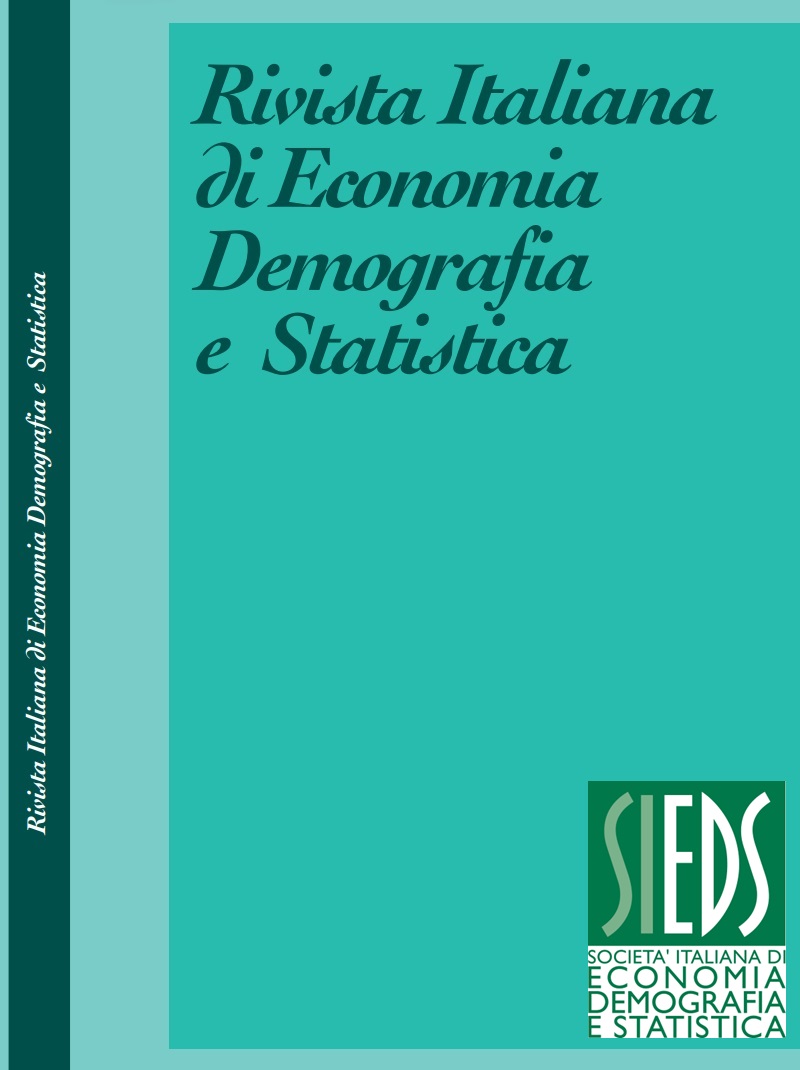Couples’ fertility differentials by education: do stepchildren make a difference?
DOI:
https://doi.org/10.71014/sieds.v79i1.301Keywords:
Fertility, Stepchildren, Educational PairingsAbstract
A growing number of studies has explored both partners’ education as determinant of couples’ fertility, acknowledging the fact that the decision to have a child is couple based. Still, those studies have solely focused on children born to the couple, without considering stepchildren. As a result, in studying couples’ birth rates by educational pairing, previous studies did not account for the complexity of family composition, which also affects partners’ decision to have a common child. In this paper, we aim at tackling family complexity and its association with education. Using Generations and Gender Surveys (GGS) data of 14 European countries, we analyse the association between educational pairing and couples’ fertility based on different definitions of couples’ children. Applying standard fertility analysis, overall results show a decline in childlessness among younger cohorts when stepchildren are considered, with strong educational difference. We found that among the younger cohorts, highly educated homogamous couples have less often stepchildren (born from one partner before the union) and remain less often without shared children. Stepchildren, instead, are more common among low educated couples, and among the heterogamous couples. We also found diversity among heterogamous couples: there are fewer stepchildren when one partner is highly educated, stepchildren more often come from the woman, especially when she is low educated.
References
ANDERSSON, L., 2023. The Role of Gender Differences in Partnering and Re-partnering for Gender Differences in Completed Fertility. Population Research and Policy Review, Vol. 42, No. 2, p. 17. DOI: https://doi.org/10.1007/s11113-023-09767-1
DI NALLO, A., 2019. Gender Gap in Repartnering: The Role of Parental Status and Custodial Arrangements. Journal of Marriage and Family, Vol. 81, No. 1, pp. 59–78. DOI: https://doi.org/10.1111/jomf.12527
GAUTHIER, A., CABAÇO, S., EMERY, T., 2018. Generations and gender survey study profile. Longitudinal and Life Course Studies, Vol. 9, No. 4, pp. 456–465. DOI: https://doi.org/10.14301/llcs.v9i4.500
GOLDSCHEIDER, F., KAUFMAN, G., SASSLER, S., 2009. Navigating the “new” marriage market. Journal of Family Issues, Vol. 30, No. 6, pp. 719–737. DOI: https://doi.org/10.1177/0192513X09331570
HARKONEN, J., DRONKERS, J., 2006. Stability and Change in the Educational Gradient of Divorce. A Comparison of Seventeen Countries. European Sociological Review, Vol. 22, No. 5, pp. 501–517. DOI: https://doi.org/10.1093/esr/jcl011
JALOVAARA, M., KREYENFELD, M., 2020. Childbearing Across Partnerships in Finland and Germany. Divorce in Europe: New Insights in Trends, Causes and Consequences of Relation Break-ups, Vol. 21, pp. 315–336. DOI: https://doi.org/10.1007/978-3-030-25838-2_15
KREYENFELD, M., GEISLER, E., CASTRO MARTÍN, T., HANNEMANN, T., HEINTZ-MARTIN, V., JALOVAARA, M., KULU, H., MEGGIOLARO, S., MORTELMANS, D., PASTEELS, I., SEIZ, M., SOLAZ, A., 2017. Social policies, separation, and second birth spacing in Western Europe. Demographic Research, Vol. 37, pp. 1245–1274. DOI: https://doi.org/10.4054/DemRes.2017.37.37
MATYSIAK, A., STYRC, M., and VIGNOLI, D., 2014. The educational gradient in marital disruption: a meta-analysis of European research findings. Population studies, Vol. 68, No. 2, pp. 197–215. DOI: https://doi.org/10.1080/00324728.2013.856459
MCLANAHAN, S. 2004. Diverging Destinies: How Children Are Faring Under the Second Demographic Transition. Demography, Vol. 41, No. 4, pp. 607–627. DOI: https://doi.org/10.1353/dem.2004.0033
MCLANAHAN, S., PERCHESKI, C., 2008. Family Structure and the Reproduction of Inequalities. Annual Review of Sociology, Vol. 34, No. 1, pp. 257–276. DOI: https://doi.org/10.1146/annurev.soc.34.040507.134549
MCNAMEE, C., RALEY, K., 2011. A note on race, ethnicity and nativity differentials in remarriage in the United States. Demographic Research, Vol. 24, pp. 293–312. DOI: https://doi.org/10.4054/DemRes.2011.24.13
NITSCHE, N., MATYSIAK, A., BAVEL, J.V., VIGNOLI, D., 2018. Partners’ Educational Pairings and Fertility across Europe. Demography, No. 38, pp. 1–36. DOI: https://doi.org/10.1007/s13524-018-0681-8
OSIEWALSKA, B., 2017. Childlessness and fertility by couples’ educational gender (in)equality in Austria, Bulgaria, and France. Demographic Research, Vol. 37, No. August, pp. 325–362. DOI: https://doi.org/10.4054/DemRes.2017.37.12
PERELLI-HARRIS, B., SIGLE-RUSHTON, W., KREYENFELD, M., LAPPEGÅRD, T., KEIZER, R., BERGHAMMER, C., 2010. The educational gradient of childbearing within cohabitation in Europe. Population and development review, Vol. 36, No. 4, pp. 775–801. DOI: https://doi.org/10.1111/j.1728-4457.2010.00357.x
RALEY, R.K., SWEENEY, M.M., 2020. Divorce, Repartnering, and Stepfamilies: A Decade in Review. Journal of Marriage and Family, Vol. 82, No. 1, pp. 81–99. DOI: https://doi.org/10.1111/jomf.12651
SCHNOR, C., VANASSCHE, S., VAN BAVEL, J., 2017. Stepfather or biological father? Education-specific pathways of postdivorce fatherhood. Demographic Research, Vol. 37, No. 1, pp. 1659–1694. DOI: https://doi.org/10.4054/DemRes.2017.37.51
SHAFER, K., JAMES, S.L., 2013. Gender and Socioeconomic Status Differences in First and Second Marriage Formation. Journal of Marriage and Family, Vol. 75, No. 3, pp. 544–564. DOI: https://doi.org/10.1111/jomf.12024
THOMSON, E. 2014. Family Complexity in Europe. The ANNALS of the American Academy of Political and Social Science, Vol. 654, No. 1, pp. 245–258. DOI: https://doi.org/10.1177/0002716214531384
THOMSON, E., MCDONALD, E., BUMPASS, L., 1990. Fertility desires and fertility: Hers, his, and theirs. Demography, Vol. 27, No. 4, pp. 579–588. DOI: https://doi.org/10.2307/2061571
TOULEMON, L. 2014. Single low-educated women and growing female hypogamy. Presented at Quetelet Seminar : 40th edition Fertility, childlessness and the family : A pluri-disciplinary approach, Louvain-la-Neuve.
TRIMARCHI, A. VAN BAVEL, J., 2018. Pathways to marital and non-marital first birth: The role of his and her education. Vienna Yearbook of Population Research, Vol. 15, pp. 143–179. DOI: https://doi.org/10.1553/populationyearbook2017s143
TRIMARCHI, A., VAN BAVEL, J., 2020. Partners’ Educational Characteristics and Fertility: Disentangling the Effects of Earning Potential and Unemployment Risk on Second Births. European Journal of Population, No. 0123456789. DOI: https://doi.org/10.1007/s10680-019-09537-w
VAN BAVEL, J. 2021. Partner choice and partner markets. Research handbook on the sociology of the family, pp. 219–231. DOI: https://doi.org/10.4337/9781788975544.00023
Downloads
Published
Issue
Section
License
Copyright (c) 2025 Alessandra Trimarchi, Laurent Toulemon

This work is licensed under a Creative Commons Attribution 4.0 International License.



